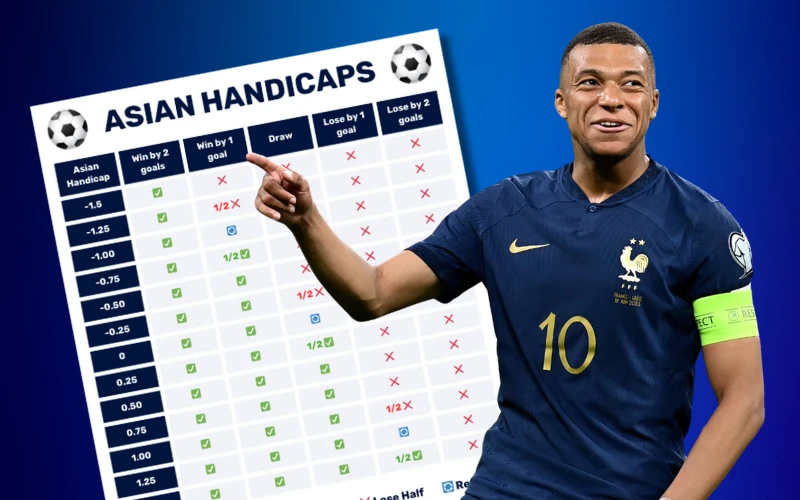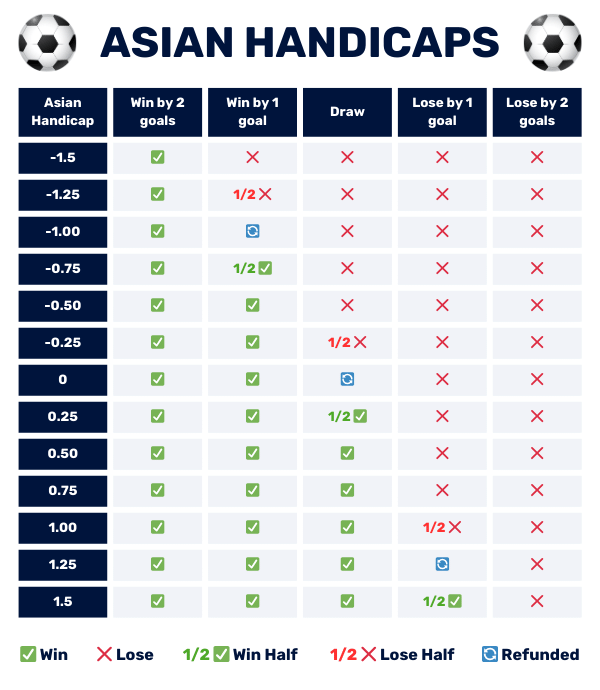Asian Handicap Betting Explained
Explore the ins and outs of Asian Handicap betting with our straightforward guide, making betting simpler and more rewarding.

Watching a football match is even more exciting when you bet on Asian handicaps. This betting method eliminates the chance of a draw, making it a 50/50 wager for who will win. And since the odds are as close as 50%, most bookmakers offer payouts close to even money (win or lose the same amount), or 1.90 to 2.00
Interesting? Let's find out more about Asian Handicap and how you can use this to your betting advantage!
What Is Asian Handicap and How Does it Work?
In regular soccer betting, there are three possible results: Team A wins, Team B wins, or the game ends in a draw. If you bet on one team to win and the game ends in a draw, you lose your bet. This can be frustrating because draws happen quite often. Asian Handicap gets its name from its origins in Indonesia, where bookmakers introduced the concept to level playing field in soccer matches where one team was a clear favorite.
Before the game even starts, one team is given a "handicap" or a "disadvantage" in goals. This is usually a fraction of a goal, like 0.5 or 1.25.
Asian Handicap Table
The chart below shows the expected results for bets placed on the Asian Handicap market and the potential winnings for each outcome.

Half-goal and Quarter-goal Handicaps
A half-goal handicap adds an extra half-goal to the underdog before the game even starts.
Let’s say, Team A gets a +0.5 handicap, here are three possible scenarios:
- If Team A wins by any score, your bet on them wins because they "overcome" the half-goal disadvantage.
- When there is a draw, your bet on Team A also wins because they're considered "up" by half a goal due to the handicap.
- You only lose your bet if Team A loses the game.
If Team B gets a -0.5 handicap, here are three possible scenarios:
- They need to win at least two goals for your bet to win.
- If they win by one goal, the bet is a push and you get your money back (because they essentially "tied" the game with the handicap).
- You lose your bet if they draw or lose the game.
Quarter-goal Handicap
This handicap is more precise and splits the difference between a half-goal and no handicap at all. It's a method to make the odds even closer to 50/50.
Let’s just say you bet $100 on a team with a +0.75 handicap. This is basically like placing two smaller bets:
- $50 bet on them winning with a +0.5 handicap (as explained above)
- $50 bet on them winning with a +1.0 handicap (suggesting they need to win by at least one goal)
This way, you still win or lose your bet based on the final score, but you have a slightly better chance of winning half your bet even if the game ends in a draw, compared to a straight half-goal handicap.
What is 0+ or 0- in Asian Handicap
Have you ever wondered what 0+ or 0- means in an Asian Handicap? 0+ and 0- are the simplest versions used to eliminate the possibility of a draw.
- 0+ (Zero Positive): This means the team you bet on starts with a zero-goal handicap. It's the equal of a standard moneyline bet (betting on a team to win without any extra conditions).
- 0- (Zero Negative): The team you bet on starts with a zero-goal disadvantage. Essentially, they need to win the match for your bet to win.
Why They Matter
- Eliminating the Draw: Even with a zero handicap, your bet can't end in a "push" (where you get your wager back). Depending on the result, you either win or lose your bet.
- Different Payouts: Generally, a 0+ handicap will give you a lower potential payout because your team has the slight advantage of not having to overcome a deficit. On the other hand, a 0- handicap can lead to a slightly higher payout, but your team needs to win as there's no "draw" option in case the match ends in a tie.
Other Types of Handicaps in Betting

Half-goal handicaps (-0.5, +0.5, -1.5, +1.5, etc.)
One team gets a head start (like starting "up" by half a goal). If the game ends up one goal apart for the teams, the bet on the team with the head start wins.
Quarter-goal handicaps (-0.25, +0.25, -0.75, +0.75, etc.)
These are trickier and work by splitting your bet between two close half-goal handicaps. For example, a +0.75 handicap is like placing half your bet on +0.5 and half on +1. This gives you a chance for a partial win even if the team scores slightly less than expected.
European handicaps (-1, +1, -2, +2, etc.)
While Asian Handicaps often use fractions, whole-goal handicaps work similarly to traditional spread betting. If you bet on a strong team with a -1 handicap. This means they need to win by at least two goals for you to win your bet. However, unlike Asian Handicaps, there's a small chance of a "draw" for your bet in this scenario. This happens if the game ends with a score that exactly reflects the handicap. For example, if you bet on a team with a -1 handicap and they win 1-0, your bet would be considered a draw and your money would be refunded.
What is an Asian Total
Okay, so what if you want more precision and ways to get rid of those frustrating 'push' situations where no one wins? This is where Asian Totals come in. They take the Over/Under concept and crank it up a notch:
Instead of just betting on "Over 2" or "Under 3" goals, Asian Totals let you use half-goals (1.5, 2.5) and even quarter-goals (1.75, 2.25). This means no more boring draws because there's always a clear winner or loser.
Types of Asian Totals
- Individual Asian Totals: You bet on the total number of goals scored by just one team. You completely ignore the other team's goals – this is perfect if you have a gut feeling about a team's scoring power.
- Split Asian Totals: These super sneaky bets are like two bets in one. You bet on something like "Over 2.75", and half your money goes on "Over 2.5" and half on "Over 3". Gives you a chance to win a bit even if your team doesn't score a ton!
How to Calculate Asian Totals?

Asian Totals are calculated based on the total number of goals scored by a team or in the entire match, but they use half-goal and quarter-goal increments instead of whole numbers. This eliminates the possibility of a "push" (where your bet is refunded) that can occur in traditional Over/Under bets if the total score lands on the exact number you bet on.
Pro Tip: You can use Asian Totals with Asian Handicap bets! Let's say a team has a big handicap, but you also think they're going to score a bunch. You can bet on them to win while also throwing in an Individual Asian Total to predict those extra goals!
Split Asian Totals
Works slightly differently, as they're essentially two separate bets in one. Here's how it works:
Your bet is split in half: For example, a bet on "Over 2.75" would split into half on "Over 2.5" and half on "Over 3".
Each half is calculated independently:
If the team scores 3 goals, the "Over 2.5" part wins, and the "Over 3" part loses. You win half your bet and lose the other half.
If the team scores 2 goals, both parts of the bet lose.
Let's Recap the Lesson
Asian handicap bets offer both pros and cons. Personally, I find them appealing because they reduce risk. With this method, I essentially get two shots at winning, which means I can either earn a small profit or avoid significant losses. Plus, since soccer tends to have low scores, Asian handicap bets Asian handicap bets can be used in your favor.
Popular Pages
Top 5 Sweepstakes Sites






